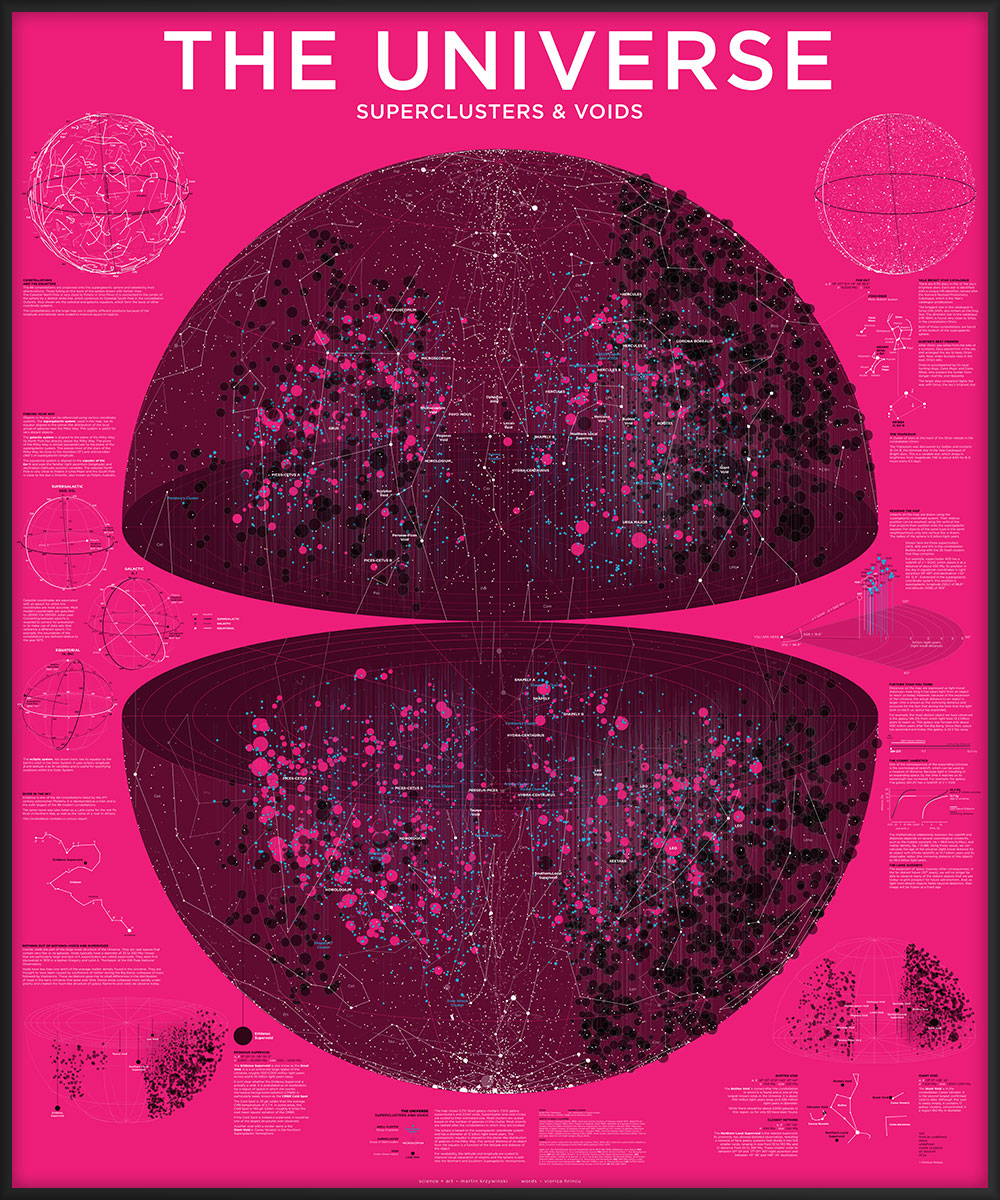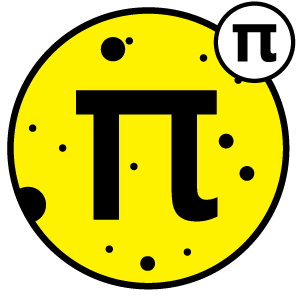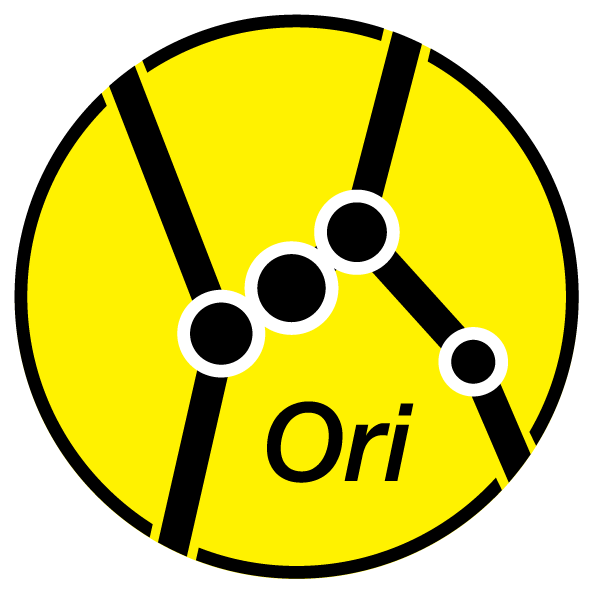null
from an undefined
place,
undefined
create (a place)
an account
of us
— Viorica Hrincu
Sometimes when you stare at the void, the void sends you a poem.
Universe—Superclusters and Voids

The average density of the universe is about `10 \times 10^{-30} \text{ g/cm}^3` or about 6 protons per cubic meter. This should put some perspective in what we mean when we speak about voids as "underdense regions".
listen: there's a hell
of a good universe next door; let's go
—e.e. cummings (pity this monster, manunkind)
designing the poster
contents
- 1 · Evolution of the Superclusters and Voids poster
- 2 · Inspiration
- 3 · VizieR astronomical catalogues
- 4 · Applying an orthographic projection
- 5 · Building the poster
- 6 · Adding stars and constellations
- 7 · Colors, fonts and design choices
- 8 · A poetic collaboration
- 9 · Interpretive panels and stories
Below I describe the design process of the poster, which is available in various color schemes.
The distances on the poster are all light-travel distances. To learn more about how distances are measured in the Universe, I've put together a short tutorial and calculator on space expansion, light-travel and comoving distances.
The reference section links to reading material about the details of individual elements, such as the coordinate system.
I was motivated by this map by Richard Powell of the Universe within 2 billion light years.

I started dutifully tracing the map and I got as far as the image below...

...before I decided that I should just parse Richard's list of superclusters and programmatically generate the map.
#Common Name Equatorial Supergal Redsh Dis Size Con Abell clusters in the # Coordinates Coords z Mly Mly in the supercluster # RA Dec L° B° Centaurus 13 00 -32.0 148 -7 0.014 194 150 Cen-Hya 1060,3526,3565,3574,3581 Perseus-Pisces 02 32 +39.8 341 -8 0.016 222 100 Per-And 262,347,426 Pavo-Indus 20 34 -37.0 230 +32 0.017 235 100 Ind-Mic 3656,3698,3742 ...
You can download a plain-text and tidied version of this file, in which the Abell list for a supercluster is now on a single line.
Below is my first attempt. This is a top-down view of the supergalactic equator. Clusters in the Southern Supergalactic Hemisphere are joined to the equator plane by dotted lines.
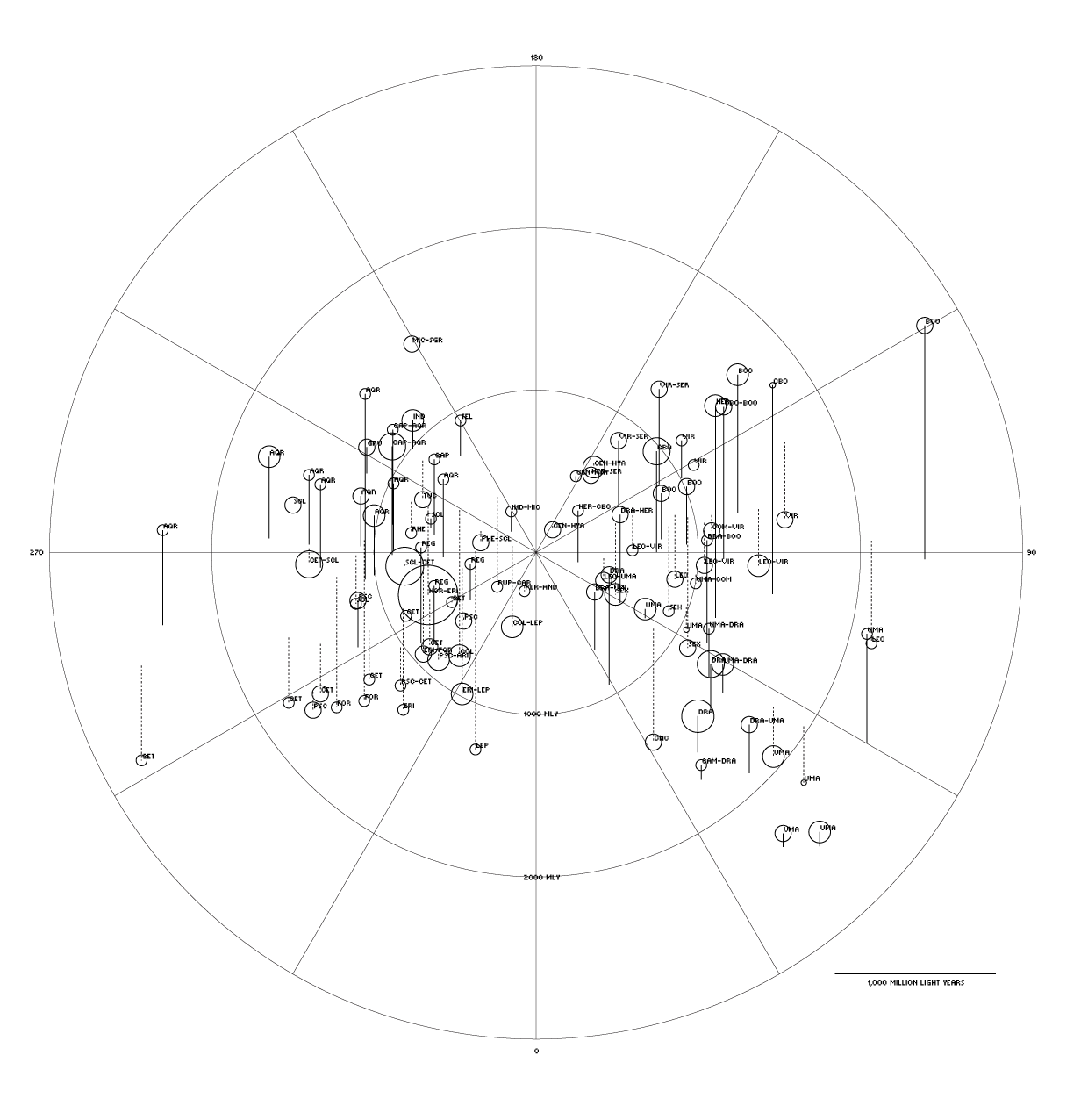
I liked the angled view of Richard's map, so I adjusted the code to achieve this.

I knew I wanted to draw the voids on the map, so I scraped some coordinates from Wikipedia's List of Voids and added them to the map.
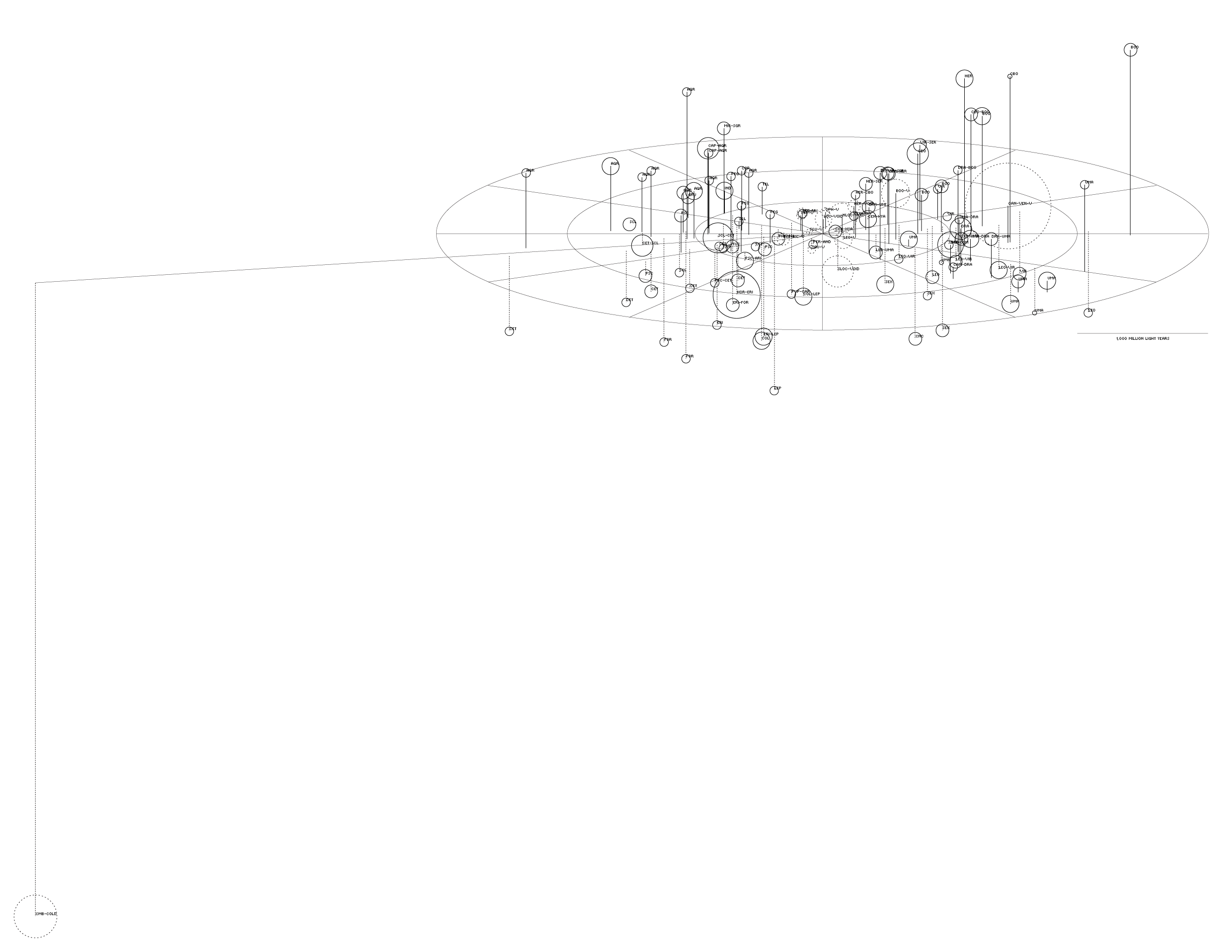
The object on the far left is the Eridanus Void, which is a hypothesized void to explain the CMBR Cold Spot. I wanted this in the map, but the scale made it difficult—Richard's list of clusters only went out as far as about 2.7 billion light-years but The Eridanus Void is between 6 and 10 billion light years away.
To accomodate this void on the map I needed either (a) more superclusters to fill out the map and/or (b) scale the distance with a log (e.g. `log(d)`) or power transformation (e.g. `d^k`).
There was also another issue: my code implemented an erzats 2-dimensional projection, not an actual orthographic or perspective 2d projection.
For more data, I went to the VizieR database of astronomical catalogues. It's a little clunky but offers a portal to an absolutely immense amount of data. Once you gain familiarity with the interface, it can feel like the Universe is within reach.
I made use of the Abell catalogue and the supercluster catalogue that groups the Abell clusters into superclusters.
VII/110A Rich Clusters of Galaxies, Abell+, 1989
J/MNRAS/445/4073 Two catalogues of superclusters, Chow-Martinez+, 2014
When these catalogues are plotted using an authentic projection, the result is the map below.

When both hemispheres are shown together, there's a lot of overlap between objects close to the equator. To mitigate this, below is my first attempt at separating the hemispheres and building a poster of the map.

Below is a close crop of a region of the poster. At this point, I'm still using the bitmap Mini 7 Condensed font and including labels for all Abell and superclusters.

Each supercluster also has its constellation designation. This tiny detail took a while to work out. The coordinates had to be precessed to 1875 to apply the IAU constellation boundary criteria.
VI/42 Identification of a Constellation From Position, Roman, 1987
To manage the density of the labels—especially the constellation labels—I thought it would be better to simply show the constellations. I thought that the natural place to put the constellations would be the surface of the supergalactic sphere at a sufficient distance from the origin to accommodate all the objects within the sphere.
I threw in the sky's brightest 9,110 stars from the Yale Catalogue of Bright Stars.
V/50 Bright Star Catalogue, 5th Revised Ed., Hoffleit+, 1991
I obtained the list of constellation shapes from Marc van der Sluys' list. For each constellation, this list gives the pairs of stars in the Yale Catalogue of Bright Stars that are connected by the constellation lines.
BSC (Yale Catalogue of Bright Stars) constellation edges. by Marc van der Sluys
However, many of Marc's constellations shapes were not the asterisms sanctioned by the IAU. I therefore corrected all the constellation shapes by manually examining the IAU map and cross-referencing the stars to the Yale Catalogue of Bright Stars. Ugh.
My list of IAU constellation shapes conveniently includes the J2000 right ascension and declination for each stars in the pair, along with their HR index, magnitude and name.
IAU Constellation shapes as edges between BSC stars (Yale Catalogue of Bright Stars) by Martin Krzywinski
For example, Cassiopeia's familiar "W" appears as 4 lines that indicate the connections between HR stars 21-168-264-403-542.
Cas 21 2.294583 59.149722 2.27 bet Caph|bet Cas|11 Cas
168 10.127083 56.537222 2.23 alf Schedar|alf Cas|18 Cas
Cas 168 10.127083 56.537222 2.23 alf Schedar|alf Cas|18 Cas
264 14.177083 60.716667 2.47 gam BU 499A|BU 1028|gam Cas|27 Cas
Cas 264 14.177083 60.716667 2.47 gam BU 499A|BU 1028|gam Cas|27 Cas
403 21.454167 60.235278 2.68 del Ruchbah|BUP 19A|del Cas|37 Cas
Cas 403 21.454167 60.235278 2.68 del Ruchbah|BUP 19A|del Cas|37 Cas
542 28.598750 63.670000 3.38 eps Segin|eps Cas|45 Cas
For more details about the constellations see my IAU Constellation Shape Resources.
At this point, I went with a vibrant magenta background and switch to the Gotham typeface for the text. I also separeated the hemispheres completely, which makes the map look a little like the hemispheres of the brain. And that's ok.
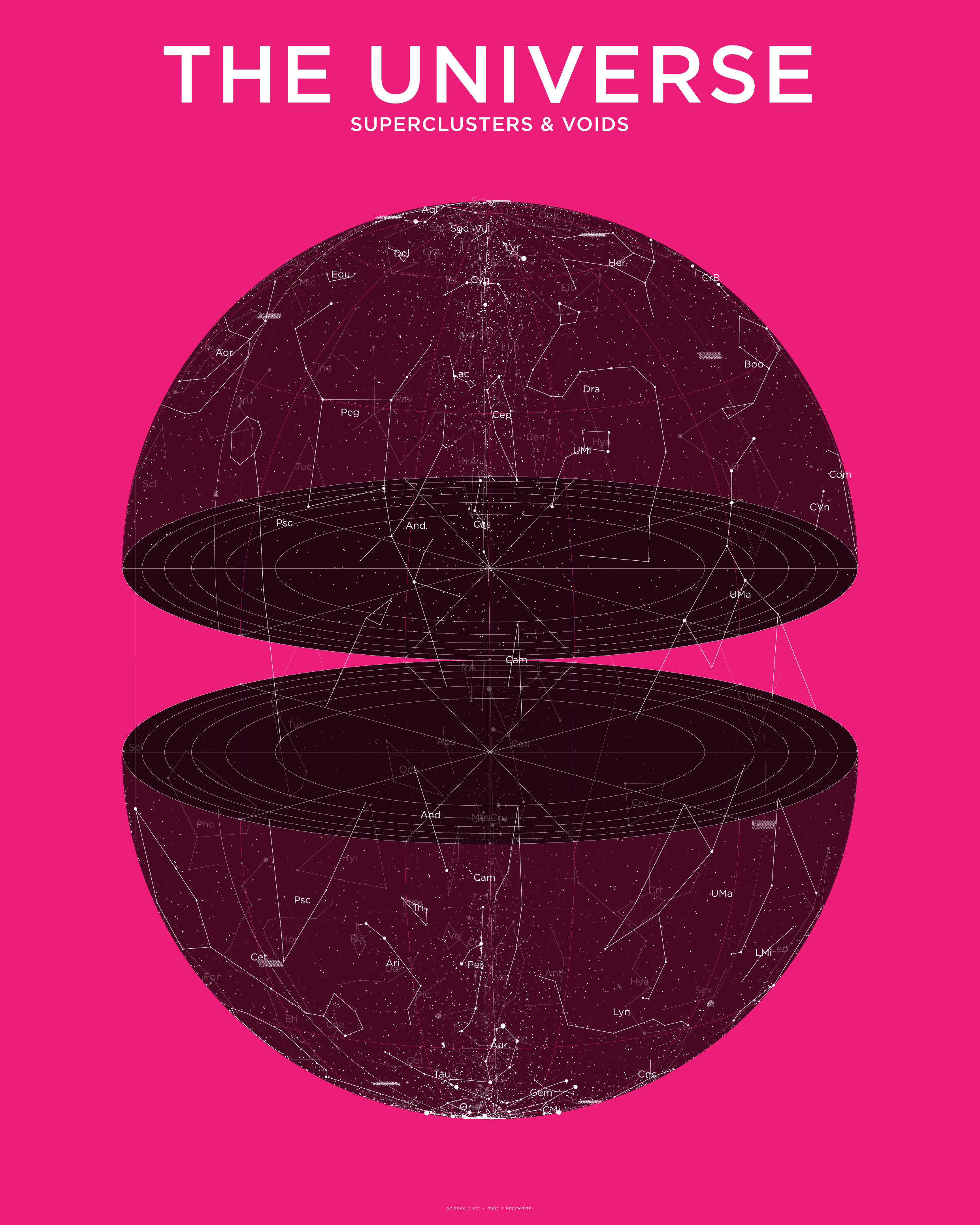
Once I dropped the Abell clusters, superclusters and voids into the sphere, it was beginning to look crowded.

From the close crop below, you can see that the drop lines for each object are clusttering the space.

I struggled with these drop lines. On one hand, I thought they were very important because they anchored the objects to the equator and thus provided a better sense of the object's position. On the other hand, they added to the busyness of the map. Ultimately I settled on a compromise. An object's drop line would only be drawn if it didn't have a neighbouring object of the same type.
I'm very eager to find ways to combine my work with poetry.
This poster features a poem by Viorica Hrincu. It's about nothingness and the somethingness that can arise from it, if we find it. It appears on the bottom right of the poster. Tucked, but not away.
null
from an undefined
place,
undefined
create (a place)
an account
of us
— Viorica Hrincu
Previously, I've collaborated with Paolo Marcazzan for my 2017 `\pi` Day `\pi` in the Sky poster. There, Paolo contributed "Of Black Body", a poem about thermodynamics, constellations and the truth we might find there. For Paolo, the poem hints at our plight (and flight): "For the earthbound, the questions and concerns remain those of identity, passage, escape from transiency, and slow tempering of hope."
It's likely that neither the coordinate system nor the elements in this map are familiar to most people. Supergalactic what? And what do you mean comoving isn't the first step in cohabitation?
To make the poster accessible, I started adding panels around the map that explained what is drawn, how to read the map, the coordinate system, what superclusters and voids are. I also threw in a few mythological stories, such as the one about Orion and his dogs and about Eridanus.
Also explained are the difference between light-travel and comoving distance along with small graphs that illustrate these concepts.
Read all the stories on the poster.

Nasa to send our human genome discs to the Moon
We'd like to say a ‘cosmic hello’: mathematics, culture, palaeontology, art and science, and ... human genomes.



Comparing classifier performance with baselines
All animals are equal, but some animals are more equal than others. —George Orwell
This month, we will illustrate the importance of establishing a baseline performance level.
Baselines are typically generated independently for each dataset using very simple models. Their role is to set the minimum level of acceptable performance and help with comparing relative improvements in performance of other models.

Unfortunately, baselines are often overlooked and, in the presence of a class imbalance5, must be established with care.
Megahed, F.M, Chen, Y-J., Jones-Farmer, A., Rigdon, S.E., Krzywinski, M. & Altman, N. (2024) Points of significance: Comparing classifier performance with baselines. Nat. Methods 20.
Happy 2024 π Day—
sunflowers ho!
Celebrate π Day (March 14th) and dig into the digit garden. Let's grow something.

How Analyzing Cosmic Nothing Might Explain Everything
Huge empty areas of the universe called voids could help solve the greatest mysteries in the cosmos.
My graphic accompanying How Analyzing Cosmic Nothing Might Explain Everything in the January 2024 issue of Scientific American depicts the entire Universe in a two-page spread — full of nothing.
The graphic uses the latest data from SDSS 12 and is an update to my Superclusters and Voids poster.
Michael Lemonick (editor) explains on the graphic:
“Regions of relatively empty space called cosmic voids are everywhere in the universe, and scientists believe studying their size, shape and spread across the cosmos could help them understand dark matter, dark energy and other big mysteries.
To use voids in this way, astronomers must map these regions in detail—a project that is just beginning.
Shown here are voids discovered by the Sloan Digital Sky Survey (SDSS), along with a selection of 16 previously named voids. Scientists expect voids to be evenly distributed throughout space—the lack of voids in some regions on the globe simply reflects SDSS’s sky coverage.”
voids
Sofia Contarini, Alice Pisani, Nico Hamaus, Federico Marulli Lauro Moscardini & Marco Baldi (2023) Cosmological Constraints from the BOSS DR12 Void Size Function Astrophysical Journal 953:46.
Nico Hamaus, Alice Pisani, Jin-Ah Choi, Guilhem Lavaux, Benjamin D. Wandelt & Jochen Weller (2020) Journal of Cosmology and Astroparticle Physics 2020:023.
Sloan Digital Sky Survey Data Release 12
Alan MacRobert (Sky & Telescope), Paulina Rowicka/Martin Krzywinski (revisions & Microscopium)
Hoffleit & Warren Jr. (1991) The Bright Star Catalog, 5th Revised Edition (Preliminary Version).
H0 = 67.4 km/(Mpc·s), Ωm = 0.315, Ωv = 0.685. Planck collaboration Planck 2018 results. VI. Cosmological parameters (2018).
constellation figures
stars
cosmology
Error in predictor variables
It is the mark of an educated mind to rest satisfied with the degree of precision that the nature of the subject admits and not to seek exactness where only an approximation is possible. —Aristotle
In regression, the predictors are (typically) assumed to have known values that are measured without error.
Practically, however, predictors are often measured with error. This has a profound (but predictable) effect on the estimates of relationships among variables – the so-called “error in variables” problem.

Error in measuring the predictors is often ignored. In this column, we discuss when ignoring this error is harmless and when it can lead to large bias that can leads us to miss important effects.
Altman, N. & Krzywinski, M. (2024) Points of significance: Error in predictor variables. Nat. Methods 20.
Background reading
Altman, N. & Krzywinski, M. (2015) Points of significance: Simple linear regression. Nat. Methods 12:999–1000.
Lever, J., Krzywinski, M. & Altman, N. (2016) Points of significance: Logistic regression. Nat. Methods 13:541–542 (2016).
Das, K., Krzywinski, M. & Altman, N. (2019) Points of significance: Quantile regression. Nat. Methods 16:451–452.
Convolutional neural networks
Nature uses only the longest threads to weave her patterns, so that each small piece of her fabric reveals the organization of the entire tapestry. – Richard Feynman
Following up on our Neural network primer column, this month we explore a different kind of network architecture: a convolutional network.
The convolutional network replaces the hidden layer of a fully connected network (FCN) with one or more filters (a kind of neuron that looks at the input within a narrow window).

Even through convolutional networks have far fewer neurons that an FCN, they can perform substantially better for certain kinds of problems, such as sequence motif detection.
Derry, A., Krzywinski, M & Altman, N. (2023) Points of significance: Convolutional neural networks. Nature Methods 20:1269–1270.
Background reading
Derry, A., Krzywinski, M. & Altman, N. (2023) Points of significance: Neural network primer. Nature Methods 20:165–167.
Lever, J., Krzywinski, M. & Altman, N. (2016) Points of significance: Logistic regression. Nature Methods 13:541–542.




